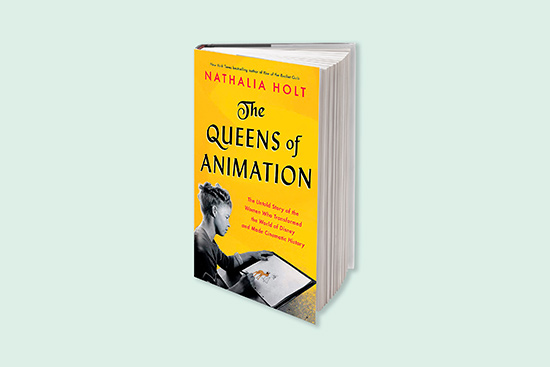
|
当艺术家和设计师比安卡·马卓丽于1935年获得了在当时看似异常理想的工作时,她的周薪为18美元,供职于迪士尼工作室知名的故事部门。当时,这个部门在短时间内负责制作了1938年的《白雪公主与七个小矮人》(Snow White and the Seven Dwarfs)以及1940年的《匹诺曹》(Pinocchio)。 作为对比,同一个部门、干着同样工作的男同事们则拿着超过75美元的周薪。 尽管你可能会像某一位紫色动画精灵那样对此感到大吃一惊,但这种差异甚至是暴行仅仅是马卓丽及其女性同事不幸的开端,而当时正值所谓的好莱坞黄金时期,同时也是动画电影的开拓时期。 在Little, Brown and Company出版的《动画皇后》(The Queens of Animation)一书中,作者纳沙利亚·霍尔特讲述了华特迪士尼动画公司初期的故事,并描述了在该部门首批(少数)女性雇员的生活和职业情况。诚然,迪士尼在20世纪20年代和30年代也有很多女性雇员,但其中的绝大多数都被下放到“油墨和着色”部门。在那里,她们费力地对每一帧画面进行最后的润色,从勾勒角色的轮廓一直到荧幕上呈现的所有色彩、花样,以及所谓的魔法。 正如该书的副标题(颠覆迪士尼王国、缔造影院历史背后鲜为人知的女性)所示,这一群动画绘制人员在荧幕上的影响力是显而易见的,并通过霍尔特对少数健在前雇员的采访或其健在友人和家人的介绍而重见天日。他们的影响力还通过素描、绘图和故事创意而跃然于纸上。有鉴于马卓丽迷人、忧郁的短片《Elmer Elephant》,人们不难找到《小飞象》(Dumbo)的原型;而她在圣迭戈动物园描绘小鹿出生的野外旅行立即让人回想起《小鹿斑比》(Bambi)的上映。 然而,在这个每天她们进出的职场,公司里的很多男性同事一再地以各种可能的方式来侵扰她们,因此其艺术才干还保留了其有关职场恶意的感受。动画绘制人员格蕾丝·亨廷顿在其中一幅个人的四格漫画中则表现得很直白,画面中有一只肥硕的老鼠(你可以猜猜是谁),慢慢地爬上了坐在她桌子前的妇女身上,伸出他超大的手掌,上面的对话泡沫写着“我爱你!”。在第二格中,画面上只有一个空桌子和一把从桌子上掉下来的椅子,而这个怪物般的老鼠感到异常吃惊,不知道自己到底都做错了什么。 在这些女性去世如此之久,几乎被人遗忘之际,霍尔特为讲述这些女性的故事所付出的努力值得赞赏。该书将其个人历史娓娓道来,似乎这些动画师扮演的就是故事中的角色。诚然,霍尔特从自身角度出发讲述了这个故事,她自己也承认这一切会令她自己和我们感到失望,因为众多的原创主题都已经消亡,她只能将素描、信件和采访信息进行拼凑,而这些采访的对象是那些能够讲述自己最初所听到内容的任何人。我们都知道,二手信息始于电话游戏,作为读者,我们很难判断书中所出现的对话是否在现实中真实发生过。 然而在大多数情况下,我们无需在意对话是否精确到一字不差,但其主旨十分明确:如果迪士尼故事部门没有招聘女性雇员,我们当前所认为的那些经典电影可能就不会具有如此大的影响力,但这个部门甚至曾经积极阻碍女性去申请这份工作。(沃尔特·迪士尼自己也存在这类问题,尽管如此,他确实曾经直接聘请了参演电影《红桃王后》的大多数女性。另外一件值得一提的事情是,所有女性都是白人。迪士尼工作室没有多元化这个理念,即便是出演批判性电影《南方之歌》的非洲裔美国明星也未获邀参加这部如今被人鄙视的电影的首映式。) 如果不是因为这本书,她们的心血可能就会被永远忽略和忽视,不幸的是,油墨与绘画部门的女性依然没能摆脱这个厄运。工作室数千名雇员参加了《白雪公主》的制作,然而如果现在观看这部影片,你会发现片头字幕中仅提到了67位工作人员的名字。(财富中文网) 译者:冯丰 审校:夏林 |
When artist and designer Bianca Majolie landed what (on paper) seems like the dream job of a lifetime in 1935, she was paid $18 per week as a member of Walt Disney Studios’ illustrious story department—then the unit that would soon become responsible for 1938’s Snow White and the Seven Dwarfs and 1940’s Pinocchio. By comparison, her male counterparts in the same role in the same department were making upwards of $75 per week. While you might be picking your jaw off the floor similar to a certain animated, violet-hued genie, this is only the beginning of some of the disparities—and even atrocities—that Majolie and her female colleagues suffered at the onset of the so-called Golden Era of Hollywood but also the pioneering days of cinematic animation. In The Queens of Animation (Little, Brown), author Nathalia Holt goes back to the earliest days of the Walt Disney Animation, tracing the lives and careers of the very first (and few) women who were hired to work in the story group. Certainly, there were many female employees at Disney in the 1920s and 1930s. But the vast majority of them were relegated to the “Ink and Paint” department, where they painstakingly put the finishing touches on each and every frame, from tracing the outlines of the characters to all of the color, flourishes, and frankly, magic that filled up the silver screen. As denoted in the book’s subtitle (The Untold Story of the Women Who Transformed the World of Disney and Made Cinematic History), the influence of this group of animators is evident on the screen, brought to light through Holt’s interviews with a few remaining former employees still alive or passed along through their surviving friends and family. Their influence also survives on the page through sketches, drawings, and story ideas. It’s not hard to pinpoint the origin of Dumbo through Majolie’s charming and melancholy Elmer Elephant short films, and how her field trip to sketch the birth of a fawn at the San Diego Zoo immediately brings to mind the opening of Bambi. But their artistic talents also preserved their feelings about the hostile workplace they entered each day as many of their male colleagues repeatedly harassed them in virtually every way imaginable. Animator Grace Huntington didn’t leave much to the imagination in one personal comic strip, depicting an obese mouse (you can guess who), creeping up on a woman at her desk, reaching over with his oversized hands with an dialogue bubble reading “I LUV YOU !” In the second cell, there is just an empty desk with a chair that has fallen over, and the ogre mouse is left dumbfounded as to what possibly he could have done wrong. Holt’s dedication to telling these women’s stories after they’ve been lost—and nearly forgotten—for so long is palpable, narrating their personal histories as if the animators were characters themselves. Admittedly, Holt had her work cut out for her as, she acknowledges to her and our dismay, that many of the original subjects are no longer living, leaving her to piece together sketches, correspondence, and interviews with whomever could pass along what they heard first. And as we all know, second-hand information is the beginning of a game of Telephone, making it a bit hard as a reader to know when some of the dialogue presented actually happened or not. But in most cases, regardless if the dialogue is word-for-word accurate or not, the theme is clear: the movies we consider classics now would not have turned out the way they did if it were not for the inclusion of women in the Disney story department, which actively discouraged women from even applying at all. (That goes for Walt Disney himself, too, although he did directly hire most of the women featured in Queens. It should also be noted that this all pertains to only white women. Diversity at the studio was nonexistent, and even the African American stars of the derogatory Song of the South were not invited to the premiere of the now-despised film.) And if it weren’t for this book, their work might have gone ignored and overlooked forever—and sadly that will remain the case for many of the women in the Ink and Paint department. Hundreds of studio employees worked on the production of Snow White, and yet only 67 are listed on the opening credits when you watch the film today. |






